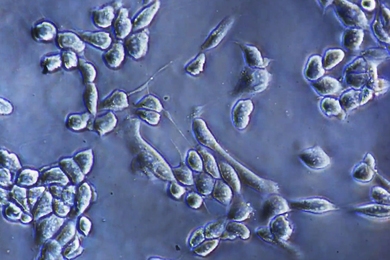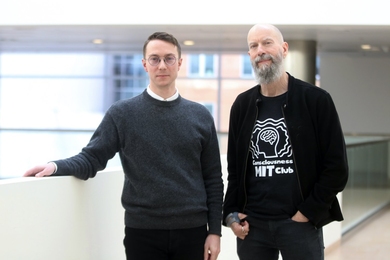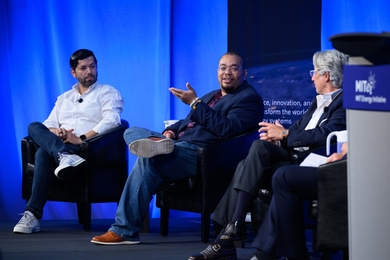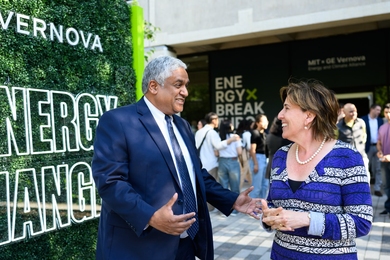It's a dream that almost anyone has who owns an old house-finding a safe secreted away, perhaps behind a chimney or under some floor boards.
Thomas White's dream safe turned up on New Year's Day, tucked away in a staircase.
It came to light, said Mr. White, technical instructor in the Department of Physics, as he and his son Richard were trying to get a telephone line up to his spare room in the house he has owned on Worthington Street in Dedham for the past 26 years.
"We had to go up through the closet and it just wouldn't work," Mr. White told reporter Kate Martin of the Dedham Times, "so Richard suggested raising a step on the stairs next to the closet for better access... and so we found this safe, stuck down there."
Naturally, Mr. White had thoughts of secret treasure.
"I couldn't believe it. This kind of stuff doesn't happen, except in the movies. I had visions of all sorts of money or something in there. You know, collectable coins, someone's buried treasure, stuff like that. Rich said right away, `I get 50 percent.' We were excited, let me tell you."
The Whites had to drill into the soft-iron safe to get the combination lock off. He estimates that the safe, weighing about 100 pounds, was made in the 1930s.
Alas, the safe appeared empty when the Whites first peered into it. Then, along the back, Mr. White's son spotted a small envelope. Inside was a letter, written on Thanksgiving Day, 1861, from Lewis Jones Houghton, one of 640 Dedham residents who fought in the Civil War, to his parents.
In it he writes about a "Grand Review" the day before that was attended by President Abraham Lincoln.
When he saw "Old Abe," he wrote, "I could not help laughing at him, he is such a comical looking fellow, his face is all wrinkled and he had an old hat, it looked as though he had worn it this twenty years..."
Mr. White, who has worked at MIT for 30 years, may have missed out on a treasure trove, but found the experience "quite exciting nonetheless."
He said his house, about 100 years old, was owned by Charles and Sarah Houghton from 1912 until 1946. Presumably, he said, they entombed the safe during that period and may have been unable to get it out when they left, or might even have overlooked it. He is not certain of their relationship to the letter writer.
He did find out that the soldier was a member of the 18th Massachusetts regiment and survived the war, which Mr. White said was a "relief."
Mr. White said that the letter, surprisingly well preserved, probably will end up in the Dedham Historical Society.
----------
A collection of "Photographs in Color" by Professor Joseph Sussman, J.R. East Professor and professor of civil and environmental engineering, is being exhibited at the Lincoln town library through February 25. Dr. Sussman is an amaetur photographer whose photos graced the The Lincoln Calendar last year (H & T, Sept. 22, 1993).
----------
A writer to the "How & Why" column in The Boston Globe asked why so many people, before putting pencil to paper, lick the tip? "Is there something about saliva that makes graphite flow better?"
For the answer, which was "yes," the Globe turned to Dr. Jack B. Howard, professor of chemical engineering, who said he himself licks his pencil tip at times.
"If the lead were truly graphite, then wetting it would probably not make a difference," said Dr. Howard, whose research includes work on graphite and other forms of carbon. But in pencil leads, he said, "the graphite is actually a mix of graphite and some clays," which are added to control the hardness of the lead.
"My observation is that wetting the pencil allows you to get a darker line," Dr. Howard said. "There's a softening of the material, some absorption of moisture into pore spaces that makes a mix that will rub off more easily. If it were pure graphite, there would be no pores to let the moisture in."
Is it a safe practice? Yes, said Dr. Howard, the graphite-clay mixture is "perfectly innocuous."
CLIPS:
Dr. Robert A. Weinberg, American Cancer Society Professor Biology, is best known as one of the nation's leading cancer researchers. But he also has considerable expertise as a cook, as revealed in a recent Boston Globe story. It told how he and a fellow scientist, Dr. David Livingston of the Dana-Farber Cancer Institute, ran the kitchen at an annual retreat in Colrean, MA. (Dr. Livingston's farmhouse) for about 25 scientists from cancer-research laboratories in the Boston area, including the Whitehead Institute for Biomedical Research, where Dr. Weinberg is a member. In the kitchen, Dr. Weinberg says in the article, he gladly takes orders from his colleague: "When we make his dishes, I defer to him. Then, when we make my dishes, I defer to him." One of Dr. Weinberg's specialties: hummus.
----------
Vanda W. Merriman, a senior majoring in nuclear engineering, was featured in an article in Graduating Engineer on minority students who have become involved in research while still undergraduates. "I thought I wanted to go into high-energy physics research," she told the magazine. "But I did research in that area and found it wasn't really interesting. Then I started leaning toward the medical aspect of nuclear engineering-finding new ways to do imaging of the body for early detection of cancer, for example." When the opportunity came up to work in MIT's Center for Cancer Research, that's where she spent long hours last summer.
----------
A Boston Globe article on radio's place on the information superhighway features Christopher M. Schmandt, principal research scientist at the Media Lab, as someone who already "eavesdrops on radio's future possibilities:"
"As he takes his evening constitutional, the 41-year-old listens to his favorite radio shows. But he carries only a cellular phone. With it, he dials up a high-powered computer in which he has stored audio selections ranging from National Public Radio's `All Things Considered' to a weekly interview show called `Geek of the Week.' By pressing buttons on the phone, he can instruct the computer to skip boring stories or long-winded introductions, and he can even speed things up, taking in a recorded 15-minute newscast in nine perfectly audible minutes."
In the story, Mr. Schmandt predicts that soon all radio listeners will have the ability to interact with programming so that they can change its time, alter its speed and rearrange its contents. "As the whole communications world shifts to being interactive and multimedia, radio is going to be right there with it," he told Globe reporter Josh Hyatt.
QUOTES:
"Why are the universities still here? Why didn't MIT say, `Boy, it's cold and clammy here. Let's go to San Diego?'"-Boston Globe columnist Marty Nolan, quoted in Boston Magazine, on the rich history and tradition of the Boston area as one of its primary attractions.
A version of this article appeared in the February 9, 1994 issue of MIT Tech Talk (Volume 38, Number 22).





